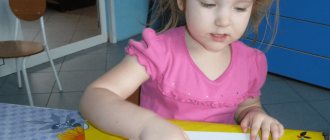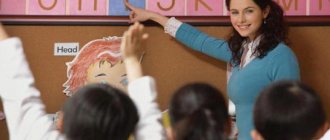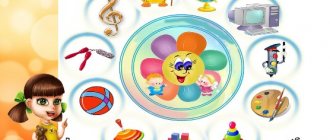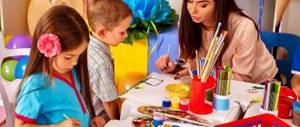Continuity in the light of state standards
By adopting the Federal State Educational Standard, the state establishes a standard of education that corresponds to the ideals of society.
The document reflects society's expectations for the level of education of preschool children. The founders, specialists, families of preschool children, and the public rely on these guidelines. The system of preschool and school education finds common points of contact and becomes a single whole. Preschool educational institutions and primary schools interact in three areas:
- Coordination of work areas for succession, goals and objectives.
- Careful selection of educational content, both in preschool educational institutions and in primary schools.
- Expanding the range of teaching methods, constantly searching for new forms of work.
Now the priority for the Russian education system has become the quality of knowledge and skills acquired by children. If there is no smooth transition between levels of education, such quality will be very difficult to achieve.
The main strategy of teachers when implementing continuity between kindergarten and school in accordance with the Federal State Educational Standard is “teaching how to learn.” Moreover, the desire and ability to learn begin to be formed not at school, but in early preschool age. When children leave school, this desire to gain knowledge should not end; it ideally continues throughout life. In accordance with the Federal State Educational Standard for primary school, one of the main tasks of this unit is the development of UUD (universal learning activities):
- personal;
- communicative;
- regulatory;
- cognitive.
Teachers and parents do not always correctly understand how to make the transition between school and kindergarten smoothly and least traumatically for a child’s psyche. They are convinced that early mastery of the first grade curriculum will make it easier for their child to adapt and help them study well. Although in reality it is not so important how well a child can read or count. The main thing is whether the prerequisites for educational activity have been formed in older preschoolers, whether the mental qualities that are significant for studying at school have been developed.
The essence of methodological work is to ensure continuity
Since methodological work is planned and carried out directly with teaching staff, it is carried out through analytical and practical activities, joint pedagogical readings, and thematic pedagogical lounges. The topic of the event is planned in advance, the tentative directions will be: “Continuity of kindergarten and school: difficulties and prospects”, “Main problems of first-graders in the first weeks of school”. It is advisable to plan and conduct mutual visits by teachers to classes and matinees. This will enable teachers to pay attention to the existing difficulties of children and plan future educational activities taking into account the problems already identified.
How to keep the educational system intact
The basis of the Federal State Educational Standard is teaching a child the ability to independently acquire knowledge. The validity of the activity approach is confirmed by scientific research, which states that any knowledge can lie as a dead weight if the child cannot apply it.
“Tell me and I’ll forget, show me and I’ll understand, let me try and I’ll remember.” The information presented by the teacher should not be perceived passively. Knowledge is not transferred to preschoolers in a ready-made form, but is mastered by them in the process of joint activities with the teacher. This is how cooperation between an adult and a child develops, as well as the communication abilities of children. Preschoolers develop psychological qualities that facilitate mastery of learning activities:
- initiative,
- independence,
- creativity,
- curiosity,
- arbitrariness.
The transition between preschool and the start of school is very difficult. It is not for nothing that so much attention is paid to the adaptation of children in the first grade. The continuity of kindergarten and school helps to make the educational environment a single whole.
The concept of “continuity” means a smooth transition from one educational level to another, preserving the methods and forms of teaching and upbringing. Teachers of the first grades of primary school will not be able to ensure a gentle adaptation of older preschoolers if they are not familiar with the methods of work of the kindergarten preparatory group teacher. If older preschoolers are not familiar with school and have no idea what awaits them beyond the school threshold, it will be very difficult to instill in them a desire to learn.
Understanding the personality traits of educators and teachers is no less important than developing interest in school. For many first-graders, the fact that there must be a certain distance between the student and the teacher becomes a great stress. In a kindergarten, the teacher is emotionally closer to the children; he, as it were, replaces the parents during the child’s stay in the preschool institution. Such differences further complicate the adaptation of first-graders who are accustomed to psychological comfort in relationships with adults.
Objectives of cooperation between teachers of preschool and school education systems:
- development of a unified concept of the process of education and upbringing at school, kindergarten and in the family;
- maximum compliance of the goals and objectives of education at various levels of education, methods of achieving them;
- educating parents on the main psychological and pedagogical areas of child development;
- creating a system of high-quality psychological support for parents to overcome problems during the transition of children to first grade from kindergarten;
- dissemination of family experience of a positive attitude towards the active activities of children in society.
Both school and kindergarten cannot be closed public institutions. Teachers and educators must be well versed in the programs of the preparatory group and the first grade of the school.
Cooperation between educational institutions and families
An important role in organizing cooperation between family and educational institution is played by the formation of ideas of teachers and parents about each other. The perception of educators by children is somewhat different from their perception of the teacher, due to the specific nature of the teacher’s activities. The continuity of the kindergarten and the family in the organization of educational influence on the child begins at the moment the child enters a preschool institution. The teacher is perceived by the child as a second mother, provided that the teacher has all the necessary empathy and professional skills. Consequently, the parents themselves are ready to listen to the advice and recommendations of the teacher, implement them, and seek help if necessary.
A primary school teacher with a first-grader finds himself at a certain distance, incomprehensible to a child who is accustomed to the fact that the teacher is a close person and first assistant. Correctly and timely restructuring the child’s perception of the teacher is a joint task of family members and employees of educational institutions. This direction is being implemented through the holding of general parent meetings, meetings of parents with future teachers, and the work of clubs for parents. Provided that all planned activities are carried out professionally, continuity between the kindergarten and the family contributes as much as possible to the formation of an adequate system of children’s perception of school and school teachers.
Methods and forms of creating continuity at the threshold of the school
With a properly organized smooth transition to school, both parents and children can always count on full information about what awaits them, on qualified help and support from psychologists and teachers.
Possible forms of work with preschoolers:
- excursions to school with visits to the gym, classroom, library, canteen, etc.;
- acquaintance with primary-level teachers and students, joint events, projects with them;
- holding joint sporting events and holidays (first bell holiday, ABC book holiday);
- participation of children in adaptation classes with teachers and primary school specialists;
- preparation of joint theatrical performances and exhibitions of artistic works.
Working with teachers:
- visits by teachers to lessons in the first grade and by teachers to educational activities in preschool educational institutions;
- joint trainings for teachers conducted by a psychologist;
- analysis of diagnostics of psychological readiness for school education of preschool educational institution graduates;
- analysis of the results of adaptation of first-graders to school education;
- holding joint seminars, master classes, round tables.
Interaction with parents of future first-graders:
- open days at school and kindergarten;
- meetings with teachers;
- consultation on current topics by teachers and psychologists;
- joint parent meetings, discussion clubs;
- training course on psychological readiness for school.
If you purposefully engage in the formation of continuity, this will help children show strong-willed efforts, initiative and self-confidence, creativity and a positive attitude towards themselves and their friends when moving to first grade.
Work plan for continuity between kindergarten and school material on the topic
| Agreed | Agreed | |
| Director of MBOU Secondary School No. 31 | Head of MBDOU d/s No. 104 | |
| _____________ E.N. Istyagina | _____________ N.A. Litovchenko | |
| t.52-18-46 | t.52-10-46 | |
Collaborative work plan of MBOU secondary school No. 31
with MBDOU d/s No. 104 “Zvonochek”
for the 2014-2015 academic year
Explanatory note
Continuity between kindergarten and primary school means a system of connections that ensures the interaction of the main tasks, content and methods of teaching and upbringing in order to create a single continuous educational process at adjacent stages of the child’s development.
Goals:
— implementation of continuity and continuity in the training and education of children in preschool and primary general education.
— reduction of negative manifestations of the adaptation period at different stages of education;
— increasing the quality level of the child’s readiness for learning in 1st grade;
— creating conditions for the development of unified approaches and criteria-evaluative indicators of the effectiveness of joint work.
The goal of the preschool stage is the harmonious development of students and the formation of their school maturity, i.e. intellectual, emotional and social readiness for learning in primary school.
The goals of the stage of primary general education are the formation of students’ ideas about nature, society, man, corresponding to the modern level of knowledge, and the priority implementation of the intellectual development of the individual.
Tasks:
· Creation of a unified educational space that would ensure the assimilation of sociocultural values by junior schoolchildren.
· Providing conditions aimed at preserving the health, emotional well-being and development of the individuality of each child.
As a result of the joint work of a working group of primary school teachers and kindergarten teachers, a succession plan is drawn up.
EXPECTED RESULT:
1. Early acquaintance and cooperation of children with the future teacher in specially organized activities.
2. Successful adaptation of first-graders to the educational process.
3. Development of a system of methodological work aimed at ensuring the quality of education and increasing the professional competence of teachers and educators.
4. Implementation of a single line of child development at the stages of preschool and primary school childhood, as an integral process that has a consistent and promising nature.
Work on continuity allows, without traumatizing the child’s psyche, to make a smooth transition from preschool life to schooling.
Collaboration plan
| No. | Types of activities, events | Deadlines | Responsible |
| Organizational and pedagogical activities | |||
| 1 | Discussion and approval of the joint work plan | September | Deputy Director for Educational Resource Management of Primary School MBOU Secondary School No. 31, Senior Teacher of MBOU D/s No. 104 |
| 2 | Organization and conduct of classes to prepare for school by primary school teachers of MBOU Secondary School № 31 | October-March | Teachers of 4th grades MBOU secondary school No. 31 |
| 3 | Open day for parents of future first-graders: — an exhibition of drawings by preschoolers “I am a future first-grader” in the secondary school; — design of thematic stands and newspapers; — attending lessons in grades 1 and 4; — a tour of the school; — collecting feedback (wishes, identifying thematic events) | February | Deputy director for water management of primary school MBOU secondary school No. 31, director of the museum, librarian, school medical worker, teachers of MBOU d/s No. 104 |
| 4 | Attendance of classes of teachers of preparatory groups of MDOU d/s No. 101 by teachers of secondary school No. 31 | Vacation time at school | Teachers of 4th grades of MBOU secondary school No. 31, educators of MBOU d/s No. 104 |
| 5 | “Visiting road signs” (a joint event on traffic rules based on MBDOU) | May | Teachers of 4th grades of MBOU secondary school No. 31, educators of MBOU d/s No. 104 |
| 6 | Excursion to the school museum for kindergarten students | October | Deputy director for water management of primary school MBOU secondary school No. 31, director of the museum, |
| 7 | “Let’s start together” Joint sporting event | April | Teachers of 4th grades of MBOU secondary school No. 31, educators of MBOU d/s No. 104 |
| Information and methodological work | |||
| 8 | Round table “Future first-grader – what is he like?” (Portrait of a first-grader in the Federal State Educational Standards system) for teachers of MBDOU d/s No. 101, 104, teachers of MBOU secondary school No. 31 | January | Teachers of 4th grades of MBOU secondary school No. 31, educators of MBOU d/s No. 104 |
| Analytical, diagnostic and correctional development activities | |||
| 9 | Information stand for parents of future first-graders “Preparing children for school” | September-May | Deputy director for water management of primary school MBOU secondary school No. 31, school psychologist |
| 10 | Determining the level of readiness of children for school | February May | School psychologist Psychologist MBDOU d/s No. 104 |
| 11 | Consultations: “Hyperactive child in kindergarten and school” "Getting Ready for School" | February | School psychologist |
| Family interaction, MBDOU, secondary school | |||
| 12 | First-grader club in kindergarten. Presentation of MBOU Secondary School No. 31. Speech by school teachers about the features of teaching children in sports classes. | 23 September | Deputy director for water management of primary school MBOU secondary school No. 31, primary school teacher, senior teacher MBOU d/s No. 104 |
| 13 | Parents' meeting "Organization of joint work of secondary schools and parents of future first-graders to prepare children for school" on the basis of MBOU Secondary School No. 31 | 22 of October | Deputy director for water management of primary school MBOU secondary school No. 31, school psychologist, primary school teachers |
| 14 | Parent meeting with parents of future first-graders “Results of training of preschoolers” on the basis of MBOU Secondary School No. 31 | April | Deputy director for water management of primary school MBOU secondary school No. 31, school psychologist, primary school teachers |
| Information and advertising activities | |||
| 15 | Development, production, distribution of advertisements about events carried out on the basis of MBOU Secondary School No. 31 to recruit and prepare children for school | September January April | Deputy director for water management of primary school MBOU secondary school No. 31, primary school teacher |
| 16 | Preparation of information and advertising presentations | September February April | Deputy director for water management of primary school MBOU secondary school No. 31, primary school teacher |
Protocol No. 1
meetings of the working group on coordinating work on the continuity of preschool and primary general education
from 09/17/2014
Topic: “Continuity in the work of kindergarten and school as a condition for the successful adaptation of children to school education”
Venue: MBDOU d/s No. 104, Volzhsky
Chairman: Bazilchuk O.P. Deputy Director for Educational Resource Management of MBOU Secondary School No. 31 Secretary: Tanskaya A.A., teacher of MBOU Secondary School No. 31
Present: 9 people
Agenda
1. Updating the problem of continuity between preschool education and primary school in the concept of lifelong education.
-Anisimova L.A. – senior teacher of MBDOU d/s No. 104
2. Ensuring continuity between MBDOU and MBOU Secondary School in the aspect of FGT and Federal State Educational Standards.”
-Bazilchuk O.P., Deputy Director for Education and Resource Management of Municipal Budgetary Educational Institution Secondary School No. 31
3. Discussion and approval of the joint work plan
-Bazilchuk O.P., Deputy Director for Education and Resource Management of Municipal Budgetary Educational Institution Secondary School No. 31
The meeting was opened by the senior teacher of MBDOU d/s No. 104 Anisimova L.A. She noted that the main strategic goal in reforming the education system is to ensure the quality of education that meets the needs of the individual and society, where an important condition is to ensure continuity of education. In turn, the main means of ensuring continuity is continuity between all levels of education, including between preschool and primary education.
In the speech of senior teacher Anisimova L.A. problems and contradictions that impede the implementation of the principle of continuity were discussed. The first problem is a certain discrepancy in ideas about the concept of “continuity” between representatives of a preschool educational institution and a school. Many teachers have only heard “something” about FGT for the main general education program of preschool education and the conditions for its implementation, about the “social portrait of a preschool graduate.” They are often not familiar with educational programs of preschool education, so difficulties arise in implementing continuity in the subject component of the educational process. In turn, preschool teachers know little about the Federal State Educational Standard. The second problem is the desire of parents to meet the requirements of a high level of development of the child without taking into account his individual characteristics. They believe that if they teach him to count and write before school, this will be the key to successful studies. The system of continuity in the work of preschool educational institutions and schools is an urgent task at the present stage.
On the second question, we listened to the Deputy Director for Educational Resource Management of MBOU No. 31 O.P. Bazilchuk. She focused on the need for close cooperation between the preschool educational institution and the school, which should be based, first of all, on the continuity of the FGT and the Federal State Educational Standard.
The speaker noted that in connection with the introduction of FGT, there was a shift in emphasis in understanding a child’s readiness to learn at school, from intellectual to personal readiness, which is determined by the formed “internal position of the student” (the child’s ability to take on a new social role as a student). She emphasized that formed cognitive motives for learning are now at the forefront, that is, the child’s conscious desire to learn, to learn something new, relying on already acquired knowledge. Those. For a modern first-grader, it becomes important not so much to possess a cognitive tool, but to be able to consciously use it. She expressed the opinion that an important link that promotes the continuity of older preschoolers and younger schoolchildren is play activity. She proposed holding joint activities to study and use effective gaming technologies that develop children’s basic abilities.
O.P. Bazilchuk gave a comparative description of the portrait of a preschool educational institution graduate, presented in the FGT, and the portrait of an elementary school graduate, which is presented in the Federal State Educational Standards of the NEO. Primary school teachers noted that the portrait of a preschool educational institution graduate in its main positions coincides with the portrait of a primary school graduate. Teachers form the same integrative personality traits in children.
Discussing issues of continuity, the working group participants came to the conclusion that an important aspect when a child moves from a preschool educational institution to school is his psychological readiness, the components of which (personal-social, motivational, intellectual, emotional-volitional spheres) can be areas of joint activity of the preschool educational institution and schools.
On the third issue, O.P. Bazilchuk, Deputy Director for Education and Resource Management of Municipal Budgetary Educational Institution Secondary School No. 31, spoke. She presented to those present a draft plan for joint work on the succession of MBOU secondary school No. 31 and MBOU d/s No. 104.
The working group participants discussed each direction and points of the plan, made their proposals and clarifications.
Solution:
1. Take note of the above conclusions. Follow common goals when preparing a child for school (portrait of a graduate).
2. Systematize the work between MBOU Secondary School No. 31 and MBOU No. 104 on organizing and conducting joint events in order to ensure continuity and continuity in the education and upbringing of children in preschool and primary general education. Approve the joint work plan for the 2014-2015 academic year.
Chairman of the working group: Bazilchuk O.P.
Secretary: Tanskaya A.A.



